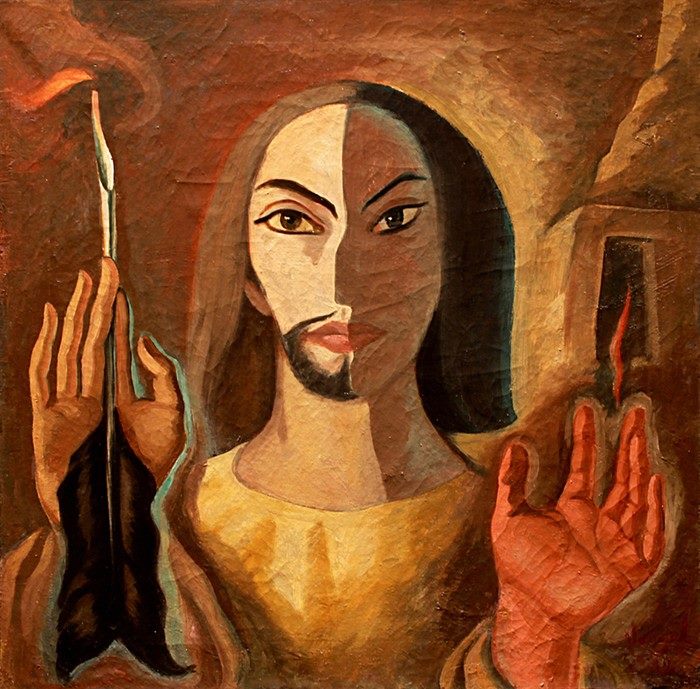A Pillar of Modernity, the Inca Garcilaso de la Vega

At the edge of a world-change, there was a Peruvian, maybe the first Peruvian. But he was not called thus. They called him Indio or Indiano, as one who came from the Indies, that is America.
When the Hidalgo of La Mancha was imagined in debate over loyalty and philosophy as a knight, even though such growing extinct, and when they Bard of the North evoked the court of Denmark, there was a Peruvian who spent time wrestling with love and learning, with the explorer of Florida, and with an empire that no longer was and whose memory was evanescing. Nonetheless, that empire challenged the criteria of the Western World.
At that time Spain hoped to domesticate it, Hispanize it. Even many of its children tried to find reason in the Christian world offered to them. Among them were created saints and images appeared, such as the Virgin of Copacabana. Indeed it was a cousin of this Peruvian, also from the nobility, who saw her and sculpted her.
This Peruvian, born in Cusco, was a “natural” son of a Spaniard with name and lineage and of a palla, an Inca princess with even more lineage and name. He grew up speaking Quechua and also Spanish. He studied while legends were still remembered and customs still commented on, just as people also spoke of Latin and the ideas and challenges of a world across the seas.

What did his mother call her baby when he barely left her womb? We do not know. That name was never registered and, unlike the Peruvians who continue with names of Indigenous lineages, such as Huamani, Condori, Yupanqui and more, he was called Gómez Suárez de Figueroa. Gómez tends to be a last name today, but it used to be a first name, from the time of its origin in Visigoth. Suárez was the last name imposed on his mother. In this way his status as bastard was made clear as was his descent from his changed-name mother.

Later, after leaving America, becoming a man of war in the last battles of the Spanish Reconquest, and settling in the most Moorish zone of Spain, in Montilla, Córdoba, in the home of his uncle, he became a man of letters.
It is not strange that his first work was a translation of a philosophical text nor that it was a humanistic text, but rather that it was of a work by Judah León Abravanel, the Hebrew. Córdoba was famous for the coexistence of Jews, Muslims and Christians during the Muslim period, when Al-Andalus, Spain, was the glory of the entire Muslim world. It was, we could say, a Cusco, a symbol of civilization and glory with a utopian tinge. In that, it was like Rome, a fabled city whose empire had left mysteries and ruins in Córdoba and even around Montilla.

By translating that work, the now Inca Garcilaso de la Vega inserted himself in the issues and life of a community, the Spanish Jews, exiled from Spain by the Catholic kings. Among the famous Jewish intellectuals of Cordoba are the great Maimonides and the amazing Averroes. Nevertheless, this world was a shadow many preferred to forget in the time of the young Gómez Suárez de Figueroa.
Of course, the Peruvian belonged to a family with great intellectuals and writers on his father’s side. Among these were the poet Garcilaso de la Vega, Jorge Manrique, and the Marquis of Santillana.
It is not surprising, as a result, that after a struggle to legitimate his relationship with his father symbolized in the certified use of the name Garcilaso de la Vega that his father had born, the same as the poet, he would add the name Inca.
He tired to return to Peru but was not allowed. The Peru of the Incas became an ever more important part of his intellectual work. He kept it from sinking into even more shadows.
In this month is celebrated the four-hundred year anniversary of the death of the English Bard, William Shakespeare, the author of the Quixote, Miguel de Cervantes, and of Inca Garcilaso de la Vega. These men who outlined crucial elements of our culture, the Englishman, the Spaniard, and the Peruvian. Garcilaso’s humanism, and his ongoing struggle to keep light amidst shadows brought together the different Cuscos of his life. They made him a pillar of today’s culture and world.




